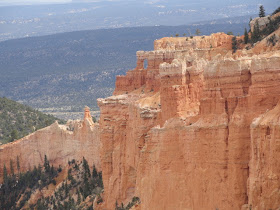As usual our first stop was the Visitors Center where we saw the film and toured the museum. Our first stop after the Visitors Center was the Lodge of Bryce Canyon constructed by the Union Pacific Railroad between 1924-1927, the only lodging available inside the park. This architectural style was used by railroads for lodges across the American west with the encouragement of the National Park Service. By now we were getting hungry and eating at the Lodge has come highly recommended and we can see why. We had a tough time figuring out what to order but we settled on a grilled veggie wrap for Jo and a portobello mushroom sandwich for Bob. Both were excellent and we would like to eat there again. Here is a photo of the Lodge.

Then we took off for Sunrise and Sunset Points. This part of the country is so beautiful. We just walked along the trail and took pictures, leaned against the railing in amazement and sat down and pondered what a great life we have on the log benches along the trail. Time really flies by when you are having as much fun as we are. Before the photos a little bit about how Bryce Canyon was formed, and is forming to this day.
Bryce Canyon is unique in that it is not a "real canyon"
carved by flowing water, but rather a giant natural amphitheater created
by erosion along the eastern side of the Paunsaugunt Plateau, part of the Colorado Plateau. Water is the active
ingredient here, but in the form of "frost-wedging" and chemical
weathering.
The erosion exposed delicate and colorful pinnacles called hoodoos that are up to 200 feet high.The geological hoodoos formed from wind, water and ice erosion of the river and lakebed sedimentary rocks. The red, orange and white colors of the rocks provide spectacular views. It is the uniqueness of the rocks that caused Bryce Canyon to be designated as a national park.
Here are some pictures from Sunrise and Sunset Points.




Next we visited Paria View Point. Here are some photos from there.


We are in a spotty internet area right next to the National Park so all the photos from Bryce Canyon will be uploaded to Flickr.com later, probably when we get to Salt Lake City.
Till next time,
Bob and Jo
Beautiful place, definitely on our list!
ReplyDeleteBryce is one of my favorite parks for sheer beauty!
ReplyDelete